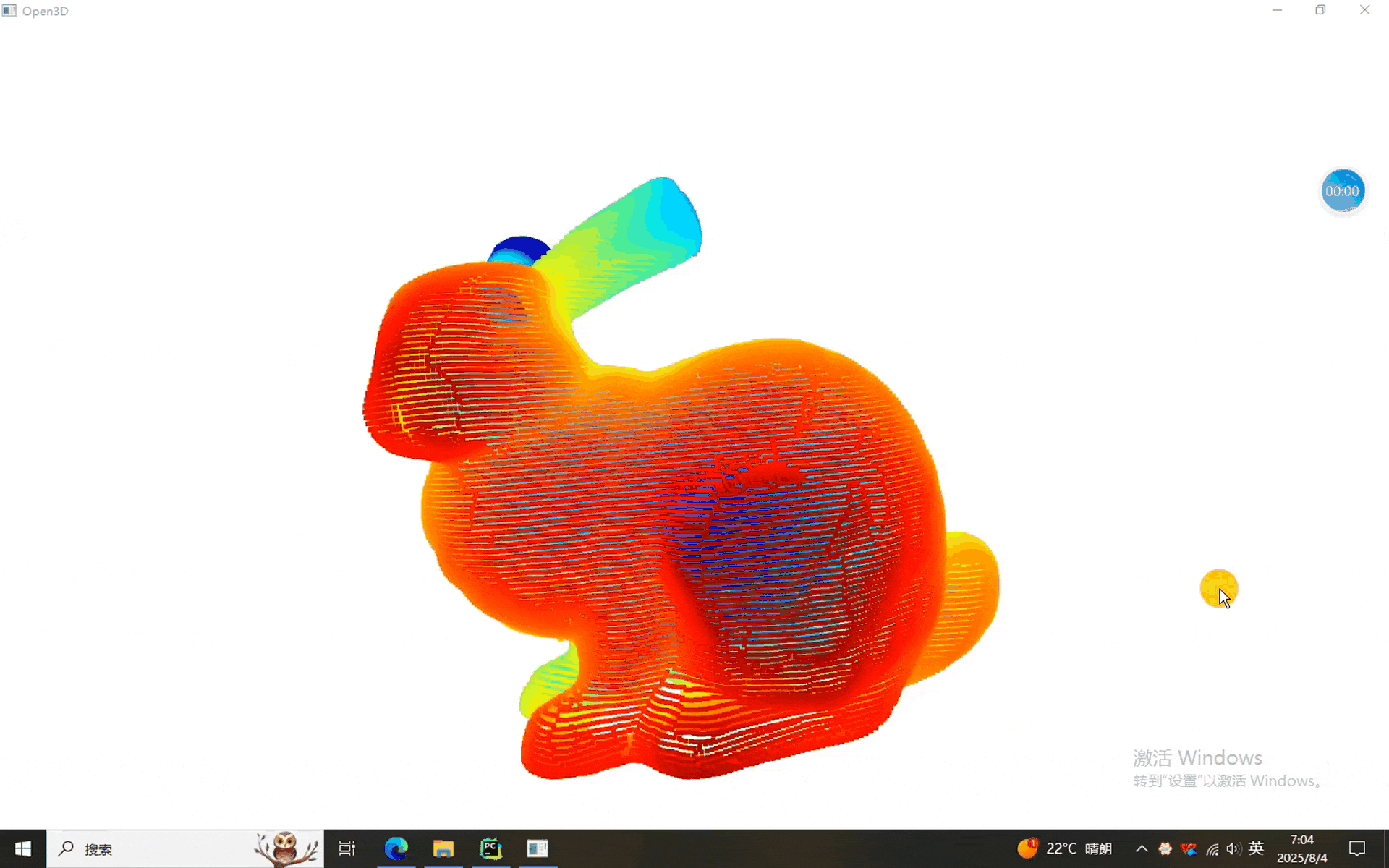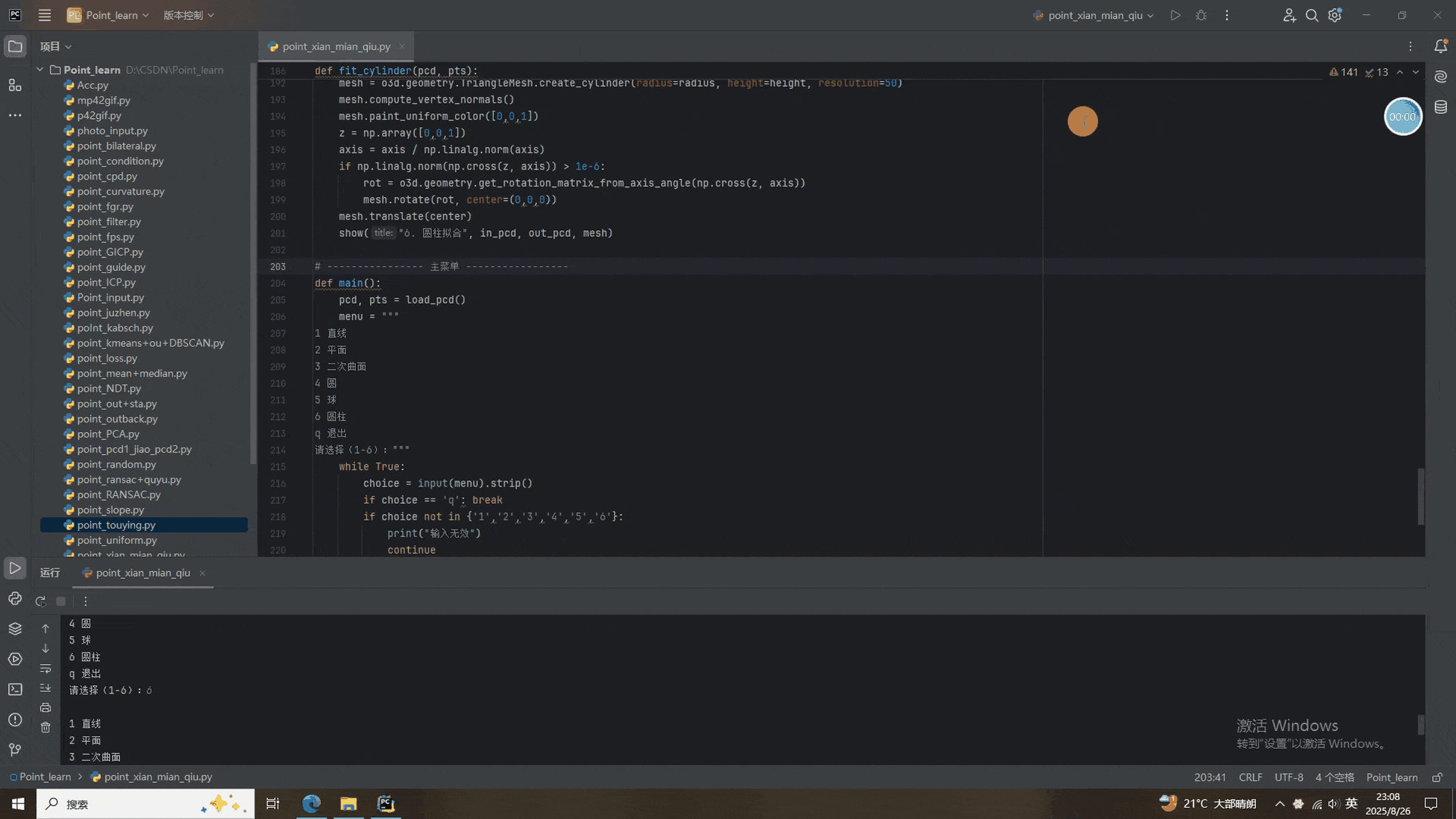本节我们分享使用RANSAC算法进行点云的拟合。RANSAC算法是什么?不知道的同学们前排罚站!(前面有)
总的来说,RANSAC(Random Sample Consensus)是一种通用的迭代鲁棒估计框架,无论拟合何种几何模型,其思想完全一致: 1. 随机采样 → 2. 最小样本拟合 → 3. 内点判定 → 4. 模型评估 → 5. 迭代收敛 → 6. 输出最优模型。
下面按"直线、平面、一般二次曲面、二维圆、三维球面、圆柱面"六种情形,给出统一的实现步骤与关键公式,便于对照查阅。
- 拟合 3D 空间直线
随机采样
- 每次随机抽取 2 个点 p₁、p₂(两点确定一条直线)。
模型估计
方向向量 v = (p₂ − p₁) / ‖p₂ − p₁‖
直线方程:L(t) = p₁ + t v,t∈ℝ
内点判定
- 点 p 到直线的距离
d = ‖(p − p₁) × v‖
若 d < d_th,则为内点。
迭代终止
- 最大迭代次数 N 或内点比例达到要求即可停止。
- 拟合 3D 平面
随机采样
- 每次随机抽取 3 个不共线的点 p₁,p₂,p₃。
模型估计
平面法向量 n = (p₂ − p₁) × (p₃ − p₁) 并归一化
平面方程:n·(x − p₁)=0,即 ax+by+cz+d=0
内点判定
- 点 p 到平面距离
d = |a·x + b·y + c·z + d| / √(a²+b²+c²)
若 d < d_th,则为内点。
- 拟合一般二次曲面
随机采样
- 二次曲面一般式 Ax²+By²+Cz²+Dxy+Eyz+Fzx+Gx+Hy+Iz+J=0 共 10 个参数,因此最少需要 9 个点(秩缺 1,需额外约束 J=1 或 ‖参数‖=1)。
模型估计
构造设计矩阵 A ∈ ℝ^{m×9} 和观测向量 b ∈ ℝ^m,用最小二乘解参数向量 θ=[A,B,...,I]^T。
得到隐式曲面方程 f(x,y,z)=0。
内点判定
- 点 p 到隐式曲面的代数距离 |f(p)| / ‖∇f(p)‖ 与阈值比较。
- 拟合 2D 圆
随机采样
- 每次随机抽取 3 个非共线的 2D 点 (x₁,y₁),(x₂,y₂),(x₃,y₃)。
模型估计
- 圆心 (a,b) 和半径 r 的闭合公式
a = [ (x₂²+y₂²−x₁²−y₁¹)(y₃−y₁) − (x₃²+y₃²−x₁²−y₁²)(y₂−y₁) ] / D
b = [ (x₃²+y₃²−x₁²−y₁²)(x₂−x₁) − (x₂²+y₂²−x₁²−y₁²)(x₃−x₁) ] / D
D = 2[(x₂−x₁)(y₃−y₁) − (x₃−x₁)(y₂−y₁)]
r = √[(x₁−a)²+(y₁−b)²]
内点判定
- 点 (x,y) 到圆的距离
|√[(x−a)²+(y−b)²] − r| < d_th。
- 拟合 3D 球面
随机采样
- 每次随机抽取 4 个非共面 3D 点 p₁...p₄。
模型估计
- 球心 c 和半径 R 的线性方程组
‖p_i − c‖² = R², i=1...4 → 4 线性方程 → 解 c、R。
内点判定
- 点 p 到球面距离
|‖p − c‖ − R| < d_th。
- 拟合 3D 圆柱面
随机采样
- 每次随机抽取 5 个 3D 点(圆柱面有 7 个自由度,但 5 点可解唯一参数,见下)。
模型估计
- 将圆柱面参数化为:
中心轴:直线 L(t)=c + t d(方向向量 d,单位化)
半径 r
- 5 点约束:任意点 p_i 到轴的距离等于 r
‖(p_i − c) × d‖ = r, i=1...5
可通过非线性最小二乘或几何代数法一次性求出 d、c、r。
内点判定
- 点 p 到圆柱面距离
|‖(p − c) × d‖ − r| < d_th。
下面书写一段RANSAC的统一处理流程(伪代码)
输入:点云 Q,几何模型类型 T,阈值 d_th,最大迭代 N
for k = 1...N
S ← RandomSample(Q, m) # m 由模型决定(2,3,4,5...)
M ← FitModel(S, T) # 见上各小节
Inliers ← {p ∈ Q | Distance(p,M) < d_th}
if |Inliers| > best_inliers
best_model ← M
best_inliers ← Inliers
输出:best_model, best_inliers
可视化
- 用 Open3D / Matplotlib / PCL 等库将原始点云和拟合几何体(直线、平面、网格化曲面、圆环、球体、圆柱网格)同时渲染。
至此,六种常见几何模型的 RANSAC 实现步骤全部给出,可直接对照代码模板进行落地。当然,本次的数据猪脚依然是我们的老朋友------兔砸!

一、RANSAC各种拟合程序
import open3d as o3d
import numpy as np
import pyransac3d as pyrsc
import random
FILE = "E:/CSDN/规则点云/bunny.pcd" # 改成自己的文件
# ---------------- 通用工具 -----------------
def load_pcd():
pcd = o3d.io.read_point_cloud(FILE)
if not pcd.has_points():
raise RuntimeError("找不到 {}".format(FILE))
return pcd, np.asarray(pcd.points)
def show(title, in_pcd, out_pcd, geom):
"""统一可视化"""
o3d.visualization.draw_geometries(
[in_pcd, out_pcd, geom],
window_name=title,
width=800, height=600
)
# AXIS = o3d.geometry.TriangleMesh.create_coordinate_frame(size=1)
# ---------------- 1. 直线 -----------------
def fit_line(pcd, pts):
def ransac_3d(points, thresh=0.05, max_iter=1000):
best_in, best_model = [], None
for _ in range(max_iter):
idx = random.sample(range(len(points)), 2)
p1, p2 = points[idx]
vec = p2 - p1
if np.linalg.norm(vec) < 1e-6:
continue
vec = vec / np.linalg.norm(vec)
dists = np.linalg.norm(np.cross(points - p1, vec), axis=1)
inliers = np.where(dists < thresh)[0]
if len(inliers) > len(best_in):
best_in = inliers
best_model = (p1, vec)
return best_model, best_in
model, idx = ransac_3d(pts, 0.05, 1000)
if model is None:
print("直线拟合失败")
return
p1, vec = model
in_pcd = pcd.select_by_index(idx).paint_uniform_color([1,0,0])
out_pcd = pcd.select_by_index(idx, invert=True).paint_uniform_color([0,1,0])
length = np.linalg.norm(pcd.get_max_bound() - pcd.get_min_bound())
start, end = p1 - vec * length, p1 + vec * length
ls = o3d.geometry.LineSet(
points=o3d.utility.Vector3dVector([start, end]),
lines=o3d.utility.Vector2iVector([[0,1]])
)
ls.colors = o3d.utility.Vector3dVector([[0,0,1]])
show("1. 直线拟合", in_pcd, out_pcd, ls)
# ---------------- 2. 平面 -----------------
def fit_plane(pcd, pts):
plane = pyrsc.Plane()
eq, idx = plane.fit(pts, thresh=0.01, maxIteration=1000)
in_pcd = pcd.select_by_index(idx).paint_uniform_color([1,0,0])
out_pcd = pcd.select_by_index(idx, invert=True).paint_uniform_color([0,1,0])
# 平面网格
aabb = in_pcd.get_axis_aligned_bounding_box()
size = max(aabb.get_extent()) * 1.5
mesh = o3d.geometry.TriangleMesh.create_box(size, size, 0.001)
mesh.translate([-size/2, -size/2, 0])
mesh.rotate(in_pcd.get_rotation_matrix_from_xyz((0,0,0)), center=(0,0,0))
normal = np.array(eq[:3])
z = np.array([0,0,1])
if np.linalg.norm(np.cross(z, normal)) > 1e-6:
rot = o3d.geometry.get_rotation_matrix_from_axis_angle(np.cross(z, normal))
mesh.rotate(rot, center=(0,0,0))
mesh.translate(in_pcd.get_center())
mesh.paint_uniform_color([0,0,1])
mesh.compute_vertex_normals()
show("2. 平面拟合", in_pcd, out_pcd, mesh)
# ---------------- 3. 二次曲面 -----------------
def fit_quadric(pcd, pts):
"""
拟合二次曲面 z = a x² + b y² + c xy + d x + e y + f
用 RANSAC 选 6 个内点,然后用最小二乘解 6 参数。
"""
def quadric_model(pts_sample):
A = np.c_[pts_sample[:,0]**2, pts_sample[:,1]**2,
pts_sample[:,0]*pts_sample[:,1],
pts_sample[:,0], pts_sample[:,1],
np.ones(len(pts_sample))]
b = pts_sample[:,2]
coeffs, *_ = np.linalg.lstsq(A, b, rcond=None)
return coeffs
def residuals(pts, coeffs):
a,b,c,d,e,f = coeffs
return np.abs(pts[:,2] - (a*pts[:,0]**2 + b*pts[:,1]**2 + c*pts[:,0]*pts[:,1] + d*pts[:,0] + e*pts[:,1] + f))
best_in, best_coeff = [], None
for _ in range(1000):
idx = random.sample(range(len(pts)), 6)
sample = pts[idx]
try:
coeff = quadric_model(sample)
except np.linalg.LinAlgError:
continue
dists = residuals(pts, coeff)
inliers = np.where(dists < 0.05)[0]
if len(inliers) > len(best_in):
best_in, best_coeff = inliers, coeff
if best_coeff is None:
print("二次曲面拟合失败")
return
in_pcd = pcd.select_by_index(best_in).paint_uniform_color([1,0,0])
out_pcd = pcd.select_by_index(best_in, invert=True).paint_uniform_color([0,1,0])
# 网格可视化
aabb = in_pcd.get_axis_aligned_bounding_box()
xx, yy = np.meshgrid(np.linspace(aabb.min_bound[0], aabb.max_bound[0], 50),
np.linspace(aabb.min_bound[1], aabb.max_bound[1], 50))
a,b,c,d,e,f = best_coeff
zz = a*xx**2 + b*yy**2 + c*xx*yy + d*xx + e*yy + f
vertices = np.stack([xx.ravel(), yy.ravel(), zz.ravel()], axis=1)
mesh = o3d.geometry.TriangleMesh()
mesh.vertices = o3d.utility.Vector3dVector(vertices)
idx = np.arange(50*50).reshape(50,50)
triangles = []
for i in range(49):
for j in range(49):
triangles.append([idx[i,j], idx[i+1,j], idx[i,j+1]])
triangles.append([idx[i+1,j], idx[i+1,j+1], idx[i,j+1]])
mesh.triangles = o3d.utility.Vector3iVector(np.array(triangles))
mesh.paint_uniform_color([0,0,1])
mesh.compute_vertex_normals()
show("3. 曲面拟合", in_pcd, out_pcd, mesh)
# ---------------- 4. 圆 -----------------
def fit_circle(pcd, pts):
pts2d = pts[:, :2] # 假设圆在 XY 平面
def ransac_circle(pts2d, thresh=0.05, max_iter=1000):
best_in, best_model = [], None
for _ in range(max_iter):
idx = random.sample(range(len(pts2d)), 3)
A,B,C = pts2d[idx]
D = 2*((B[0]-A[0])*(C[1]-A[1]) - (B[1]-A[1])*(C[0]-A[0]))
if abs(D) < 1e-6: continue
cx = ((C[1]-A[1])*(B[0]**2+B[1]**2-A[0]**2-A[1]**2) - (B[1]-A[1])*(C[0]**2+C[1]**2-A[0]**2-A[1]**2)) / D
cy = ((B[0]-A[0])*(C[0]**2+C[1]**2-A[0]**2-A[1]**2) - (C[0]-A[0])*(B[0]**2+B[1]**2-A[0]**2-A[1]**2)) / D
r = np.linalg.norm([A[0]-cx, A[1]-cy])
dists = np.abs(np.linalg.norm(pts2d - [cx,cy], axis=1) - r)
inliers = np.where(dists < thresh)[0]
if len(inliers) > len(best_in):
best_in, best_model = inliers, (cx, cy, r)
return best_model, best_in
model, idx = ransac_circle(pts2d, 0.05, 1000)
if model is None:
print("圆拟合失败")
return
cx,cy,r = model
in_pcd = pcd.select_by_index(idx).paint_uniform_color([1,0,0])
out_pcd = pcd.select_by_index(idx, invert=True).paint_uniform_color([0,1,0])
theta = np.linspace(0, 2*np.pi, 100)
x = cx + r*np.cos(theta)
y = cy + r*np.sin(theta)
z = np.zeros_like(x)
circle_pts = np.vstack([x,y,z]).T
ls = o3d.geometry.LineSet(points=o3d.utility.Vector3dVector(circle_pts),
lines=o3d.utility.Vector2iVector([[i,(i+1)%100] for i in range(100)]))
ls.colors = o3d.utility.Vector3dVector([[0,0,1] for _ in range(100)])
show("4. 圆拟合", in_pcd, out_pcd, ls)
# ---------------- 5. 球 -----------------
def fit_sphere(pcd, pts):
sph = pyrsc.Sphere()
center, radius, idx = sph.fit(pts, thresh=0.05, maxIteration=1000)
in_pcd = pcd.select_by_index(idx).paint_uniform_color([1,0,0])
out_pcd = pcd.select_by_index(idx, invert=True).paint_uniform_color([0,1,0])
mesh = o3d.geometry.TriangleMesh.create_sphere(radius=radius)
mesh.translate(center)
mesh.paint_uniform_color([0,0,1])
mesh.compute_vertex_normals()
show("5. 球拟合", in_pcd, out_pcd, mesh)
# ---------------- 6. 圆柱 -----------------
def fit_cylinder(pcd, pts):
cyl = pyrsc.Cylinder()
axis, center, radius, idx = cyl.fit(pts, thresh=0.05, maxIteration=1000)
in_pcd = pcd.select_by_index(idx).paint_uniform_color([1,0,0])
out_pcd = pcd.select_by_index(idx, invert=True).paint_uniform_color([0,1,0])
height = np.linalg.norm(pcd.get_max_bound() - pcd.get_min_bound()) * 1.2
mesh = o3d.geometry.TriangleMesh.create_cylinder(radius=radius, height=height, resolution=50)
mesh.compute_vertex_normals()
mesh.paint_uniform_color([0,0,1])
z = np.array([0,0,1])
axis = axis / np.linalg.norm(axis)
if np.linalg.norm(np.cross(z, axis)) > 1e-6:
rot = o3d.geometry.get_rotation_matrix_from_axis_angle(np.cross(z, axis))
mesh.rotate(rot, center=(0,0,0))
mesh.translate(center)
show("6. 圆柱拟合", in_pcd, out_pcd, mesh)
# ---------------- 主菜单 -----------------
def main():
pcd, pts = load_pcd()
menu = """
1 直线
2 平面
3 二次曲面
4 圆
5 球
6 圆柱
q 退出
请选择(1-6):"""
while True:
choice = input(menu).strip()
if choice == 'q': break
if choice not in {'1','2','3','4','5','6'}:
print("输入无效")
continue
if choice == '1': fit_line(pcd, pts)
if choice == '2': fit_plane(pcd, pts)
if choice == '3': fit_quadric(pcd, pts)
if choice == '4': fit_circle(pcd, pts)
if choice == '5': fit_sphere(pcd, pts)
if choice == '6': fit_cylinder(pcd, pts)
if __name__ == "__main__":
main()二、RANSAC各种拟合结果

本次的程序添加了选择按钮,1-6分别是RANSAC拟合直线、平面、曲面、圆、球面、圆柱面。除了圆柱面拟合过于离谱(主要兔砸长得不像柱子),其他的都挺好。
就酱,下次见^-^